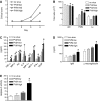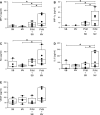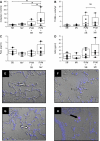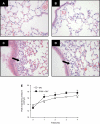Mechanical ventilation enhances lung inflammation and caspase activity in a model of mouse pneumovirus infection
- PMID: 18996903
- PMCID: PMC2636950
- DOI: 10.1152/ajplung.00467.2007
Mechanical ventilation enhances lung inflammation and caspase activity in a model of mouse pneumovirus infection
Abstract
Severe infection with respiratory syncytial virus (RSV) in children can progress to respiratory distress and acute lung injury (ALI). Accumulating evidence suggests that mechanical ventilation (MV) is an important cofactor in the development of ALI by modulating the host immune responses to bacteria. This study investigates whether MV enhances the host response to pneumonia virus of mice (PVM), a mouse pneumovirus that has been used as a model for RSV infection in humans. BALB/c mice were inoculated intranasally with diluted clarified lung homogenates from mice infected with PVM strain J3666 or uninfected controls. Four days after inoculation, the mice were subjected to 4 h of MV (tidal volume, 10 ml/kg) or allowed to breathe spontaneously. When compared with that of mice inoculated with PVM only, the administration of MV to PVM-infected mice resulted in increased bronchoalveolar lavage fluid concentrations of the cytokines macrophage inflammatory protein (MIP)-2, MIP-1alpha (CCL3), and IL-6; increased alveolar-capillary permeability to high molecular weight proteins; and increased caspase-3 activity in lung homogenates. We conclude that MV enhances the activation of inflammatory and caspase cell death pathways in response to pneumovirus infection. We speculate that MV potentially contributes to the development of lung injury in patients with RSV infection.
Figures







Similar articles
-
Role of the Fas/FasL system in a model of RSV infection in mechanically ventilated mice.Am J Physiol Lung Cell Mol Physiol. 2011 Oct;301(4):L451-60. doi: 10.1152/ajplung.00368.2010. Epub 2011 Jul 8. Am J Physiol Lung Cell Mol Physiol. 2011. PMID: 21743025 Free PMC article.
-
Pneumovirus-Induced Lung Disease in Mice Is Independent of Neutrophil-Driven Inflammation.PLoS One. 2016 Dec 22;11(12):e0168779. doi: 10.1371/journal.pone.0168779. eCollection 2016. PLoS One. 2016. PMID: 28005954 Free PMC article.
-
Glucocorticoid administration accelerates mortality of pneumovirus-infected mice.J Infect Dis. 2001 Dec 15;184(12):1518-23. doi: 10.1086/324664. Epub 2001 Dec 3. J Infect Dis. 2001. PMID: 11740726
-
The Pneumonia Virus of Mice (PVM) model of acute respiratory infection.Viruses. 2012 Dec;4(12):3494-510. doi: 10.3390/v4123494. Viruses. 2012. PMID: 23342367 Free PMC article. Review.
-
The pneumonia virus of mice infection model for severe respiratory syncytial virus infection: identifying novel targets for therapeutic intervention.Pharmacol Ther. 2005 Jan;105(1):1-6. doi: 10.1016/j.pharmthera.2004.09.001. Pharmacol Ther. 2005. PMID: 15626452 Review.
Cited by
-
Knockdown of lung phosphodiesterase 2A attenuates alveolar inflammation and protein leak in a two-hit mouse model of acute lung injury.Am J Physiol Lung Cell Mol Physiol. 2011 Aug;301(2):L161-70. doi: 10.1152/ajplung.00073.2011. Epub 2011 May 13. Am J Physiol Lung Cell Mol Physiol. 2011. PMID: 21571906 Free PMC article.
-
Persistent Airway Hyperresponsiveness Following Recovery from Infection with Pneumonia Virus of Mice.Viruses. 2021 Apr 22;13(5):728. doi: 10.3390/v13050728. Viruses. 2021. PMID: 33922096 Free PMC article.
-
Mechanical Ventilation Exacerbates Poly (I:C) Induced Acute Lung Injury: Central Role for Caspase-11 and Gut-Lung Axis.Front Immunol. 2021 Jul 19;12:693874. doi: 10.3389/fimmu.2021.693874. eCollection 2021. Front Immunol. 2021. PMID: 34349759 Free PMC article.
-
Application of fiberoptic bronchscopy in patients with acute exacerbations of chronic obstructive pulmonary disease during sequential weaning of invasive-noninvasive mechanical ventilation.World J Emerg Med. 2012;3(1):29-34. doi: 10.5847/wjem.j.issn.1920-8642.2012.01.005. World J Emerg Med. 2012. PMID: 25215035 Free PMC article.
-
Experimental models and emerging hypotheses for acute lung injury.Crit Care Clin. 2011 Jul;27(3):735-52. doi: 10.1016/j.ccc.2011.05.013. Crit Care Clin. 2011. PMID: 21742226 Free PMC article. Review.
References
-
- Albuali WH, Singh RN, Fraser DD, Seabrook JA, Kavanagh BP, Parshuram CS, Kornecki A. Have changes in ventilation practice improved outcome in children with acute lung injury? Pediatr Crit Care Med 8: 324–330, 2007. - PubMed
-
- Altemeier WA, Matute-Bello G, Frevert CW, Kawata Y, Kajikawa O, Martin TR, Glenny RW. Mechanical ventilation with moderate tidal volumes synergistically increases lung cytokine response to systemic endotoxin. Am J Physiol Lung Cell Mol Physiol 287: L533–L542, 2004. - PubMed
-
- Altemeier WA, Matute-Bello G, Gharib SA, Glenny RW, Martin TR, Liles WC. Modulation of lipopolysaccharide-induced gene transcription and promotion of lung injury by mechanical ventilation. J Immunol 175: 3369–3376, 2005. - PubMed
-
- [Anon]. Ventilation with lower tidal volumes compared with traditional tidal volumes for acute lung injury and the acute respiratory distress syndrome. The Acute Respiratory Distress Syndrome Network. N Engl J Med 342: 1301–1308, 2000. - PubMed
Publication types
MeSH terms
Substances
Grants and funding
LinkOut - more resources
Full Text Sources
Other Literature Sources
Medical
Research Materials

